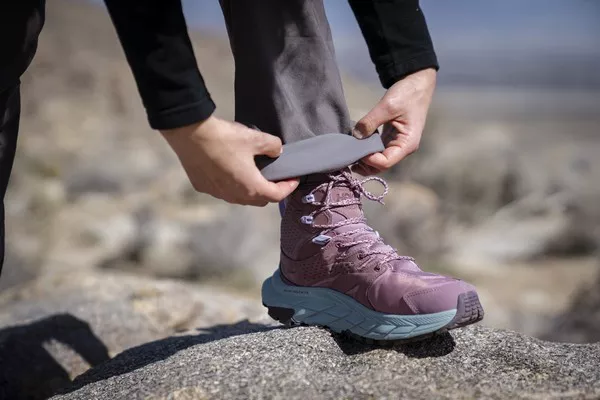Choosing the right walking boots is essential for comfort, support, and safety on your outdoor adventures. This guide will cover everything you need to consider when selecting the perfect pair of walking boots.
1. Fit and Sizing
The fit of your walking boots is the most crucial factor. A proper fit prevents blisters, discomfort, and injuries.
Measure Your Feet
Length: Stand on a flat surface and measure from the heel to the longest toe.
Width: Measure the widest part of your foot.
Arch Type: Consider your arch height. You can do this by wetting your foot and stepping on a piece of paper. The footprint will indicate if you have a flat, medium, or high arch.
Try Them On
Wear Appropriate Socks: Bring the socks you plan to wear when walking.
Check the Toebox: Ensure there is enough space (about a thumb’s width) between your toes and the front of the boot.
Heel Fit: Your heel should fit snugly without slipping.
Break Them In
New boots can feel stiff. Wear them around the house or on short walks to break them in before hitting the trails.
2. Boot Height
Walking boots come in various heights, affecting support and protection.
Low-Cut Boots
Best For: Light hiking and casual walks.
Advantages: Lightweight and flexible, offering good freedom of movement.
Mid-Cut Boots
Best For: Day hikes and moderate trails.
Advantages: Provide more ankle support than low-cut boots without being too heavy.
High-Cut Boots
Best For: Backpacking and rugged terrain.
Advantages: Offer maximum ankle support and protection from rocks and debris.
3. Materials
The materials used in walking boots significantly impact their performance and durability.
Upper Materials
Leather: Offers durability and water resistance. It requires a break-in period but is very supportive.
Synthetic: Lighter and more breathable than leather. It dries quickly and often comes with water-resistant treatments.
Lining Materials
Gore-Tex: A waterproof and breathable membrane that keeps your feet dry.
Mesh: Provides excellent ventilation but may not be waterproof.
Outsole Materials
Rubber: Provides good grip and durability. Look for Vibram rubber for better traction on various surfaces.
Tread Pattern: Deeper lugs offer better grip on slippery or uneven terrain.
4. Weight
The weight of your walking boots can impact your endurance on longer hikes.
Lightweight Boots
Best For: Fast hikes and short distances.
Advantages: Less fatigue and easier to carry.
Heavy-Duty Boots
Best For: Backpacking and rugged terrain.
Advantages: More support and protection but can cause fatigue over long distances.
5. Cushioning and Support
Good cushioning absorbs shock and provides comfort, while proper support prevents injuries.
Midsole
Material: EVA foam or PU foam provides cushioning and support.
Thickness: Thicker midsoles generally offer more cushioning but can be heavier.
Arch Support
Importance: Proper arch support prevents foot fatigue and pain.
Customization: Consider custom insoles if you need extra support.
6. Traction
Good traction is vital for stability on different terrains.
Tread Design
Lug Pattern: Deeper lugs improve grip. Look for a combination of flat areas and deep lugs for various conditions.
Siped Soles: Thin slits in the rubber enhance grip on wet surfaces.
Surface Compatibility
Rocky Terrain: Choose boots with aggressive treads for better grip.
Mud and Snow: Wider lugs help prevent the boots from getting stuck.
7. Waterproofing
Staying dry is crucial for comfort and health during hikes.
Waterproof Membranes
Gore-Tex: Offers excellent waterproofing while allowing breathability.
Water-Resistant Treatments: Some boots have a water-resistant coating but may not be fully waterproof.
Seam Sealing
Importance: Sealed seams prevent water from entering through stitching.
Check for Sealing: Inspect the seams for a fully sealed construction.
8. Breathability
Breathable boots keep your feet dry and comfortable by allowing moisture to escape.
Ventilation Features
Mesh Panels: Some boots have mesh areas for increased airflow.
Breathable Linings: Look for moisture-wicking linings to keep feet dry.
9. Ankle Support
Proper ankle support is vital for preventing injuries, especially on uneven terrain.
Cushioned Collars
Importance: A padded collar helps stabilize the ankle and reduces pressure points.
Height Matters: Higher boots provide more support but can limit mobility.
Stability Features
Stiffness: Stiffer boots offer more support but may require a break-in period.
Flexibility: Look for a balance between support and flexibility for comfort.
10. Price and Value
Walking boots come at various price points. While it can be tempting to choose cheaper options, consider the following:
Quality vs. Cost
Invest in Quality: Higher-quality boots may cost more upfront but offer better durability and comfort.
Long-Term Use: Good boots last longer, saving money in the long run.
Sales and Discounts
Shop Wisely: Look for sales or discounts to find quality boots within your budget.
Compare Brands: Different brands offer various features at different price points.
11. Brand Reputation
Choosing a reputable brand can ensure quality and reliability.
Research Brands
Popular Brands: Look for brands known for outdoor footwear, like Merrell, Salomon, and Scarpa.
Read Reviews: Customer feedback provides insights into performance and comfort.
12. Additional Features
Some extra features can enhance your walking experience.
Lacing Systems
Traditional Laces: Allow for customization in fit but may come undone.
Quick-Lacing Systems: Easy to adjust but may be less secure.
Heel Lock
Importance: A heel lock feature keeps your heel in place, reducing movement and blisters.
Removable Insoles
Customization: Removable insoles allow for customization with orthotics if needed.
Conclusion
Choosing the right walking boots is essential for an enjoyable outdoor experience. Pay attention to fit, materials, weight, and features to find the perfect pair for your needs. With the right walking boots, you can tackle any trail confidently and comfortably. Happy hiking!
Related topics:
- Are Danner Boots Good for Hiking?
- What Type of Material is Good for Hiking Clothes
- Are Danner Hiking Boots Good? A Comprehensive Review

